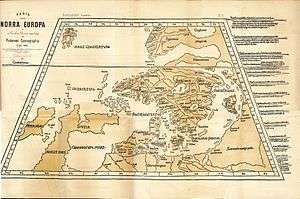Northern Europe


Northern Europe is the northern part or region of Europe. Although no definitive borders or definition exists for the term, geographically, northern Europe consists of (from west to east): Iceland, Ireland, the Isle of Man, the United Kingdom, the Faroe Islands, the Netherlands, northern Germany, Denmark, Norway, Sweden, Finland, Estonia, Latvia, Lithuania, Belarus and northwest Russia. Greenland, geographically a part of North America, is politically a part of the Kingdom of Denmark, and may be included depending on the definition.[1]
History

Historically, when Europe was dominated by the Mediterranean region (i.e., the Roman Empire), everything not near this sea was termed northern Europe, including Germany, the Low Countries, and Austria. This meaning is still used today in some contexts, such as in discussions of the Northern Renaissance. In medieval times, the term (Ultima) Thule was used to mean a mythical place in the extreme northern reaches of the continent.
Geography
.png)
Blue – Northern Europe
Green – Western Europe
Red – Eastern Europe
Yellow – Southern Europe
Grey – Territories not considered part of Europe
Northern Europe consists roughly of the Scandinavian Peninsula, the peninsula of Jutland, the Baltic plain that lies to the east and the many islands that lie offshore from mainland northern Europe, Greenland, and the main European continent.
The area is defined by the volcanic islands of the far northwest, notably Iceland and Jan Mayen, the mountainous western seaboard, extending from the mountainous sections of Great Britain and Ireland to the Scandinavian mountains peaking in Norway, the central north mountains and hills of Sweden (which are the foothills of the Scandinavian mountains) and the large eastern plain, which contains, Lithuania, Latvia, Estonia and Finland.
The region has a south west extreme of around 50 degrees north and a northern extreme of 81 degrees north. The entire region's climate is mildly affected by the Gulf Stream. From the west climates vary from maritime and maritime subarctic climates. In the north and central climates are generally subarctic or Arctic and to the east climates are mostly subarctic and temperate/continental.
Just as both climate and relief are variable across the region, so too is vegetation also extremely variable, with sparse tundra in the north and high mountains, boreal forest on the north-eastern and central regions temperate coniferous forests (formerly of which a majority was in the Scottish Highlands and south west Norway) and temperate broadleaf forests growing in the south, west and temperate east.
With the exception of the UK and Ireland, northern European countries are known for harsh winters with temperatures reaching as low as minus 50 degrees Celsius in some parts.[2]
Demographics
Countries in Northern Europe have large, developed economies and some of the highest standards of living in the world. They often score highly on surveys measuring quality-of-life, such as the Human Development Index.
See also
| Wikimedia Commons has media related to Northern Europe. |
References
- ↑ "Geography FAQs". National Geographic. Retrieved March 2016. Check date values in:
|access-date=(help) - ↑ "Norway Climate". Visit Norway. 2011. Retrieved October 2011. Check date values in:
|access-date=(help)